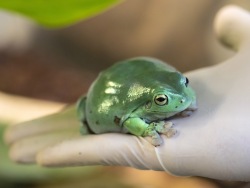Horned and Australian tree frogs become parents

“This is the first brood for the Chacoan horned frogs living in the Tropical Rain Forest exhibit of the Primorsky Aquarium,” says Artyom Gerasimenko, a staff member of the Tropical Rain Forest Department. “Interestingly, the babies displayed some of the species’ personality traits right after hatching”.
The amphibians that get their common name from the horn-like projections on upper eyelids are voracious predators. Calm hunters in the wild, Chacoan horned frogs have mighty jaws with a row of pointed teeth and try to eat anything that moves and can fit in their huge mouths. Insects, fishes and even unwary small mammals may, in a flash, end up as a frog’s lunch. These frogs are also known for cannibalism and capable of consuming their counterparts, even of a larger size.
No wonder their tadpoles show a hereditary harsh temper. To avoid cannibalism in the “nursery”, the aquarists place the growing tadpoles in separate tanks, creating extremely comfortable conditions for their further development.
The courtship of a male Australian green tree frog has been successful too. Unlike in the case of horned frogs, it is not the first time that the species has reproduced at the Primorsky Aquarium.
Captive breeding of amphibians is rather a complicated and painstaking process. The Aquarium’s biologists had to replicate the climate conditions specific to the native environment of the Australian green tree frog so that the romantic songs of a male could reach the heart of its mate. Artificial wintering, an individual regimen of misting for imitating the rainy season, monitoring of the male’s calls and the female’s weight gain, and voilà – the new offspring of these frogs are undergoing a metamorphosis to turn from tadpoles into froglets.